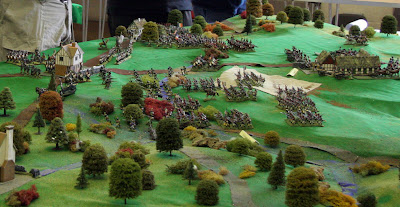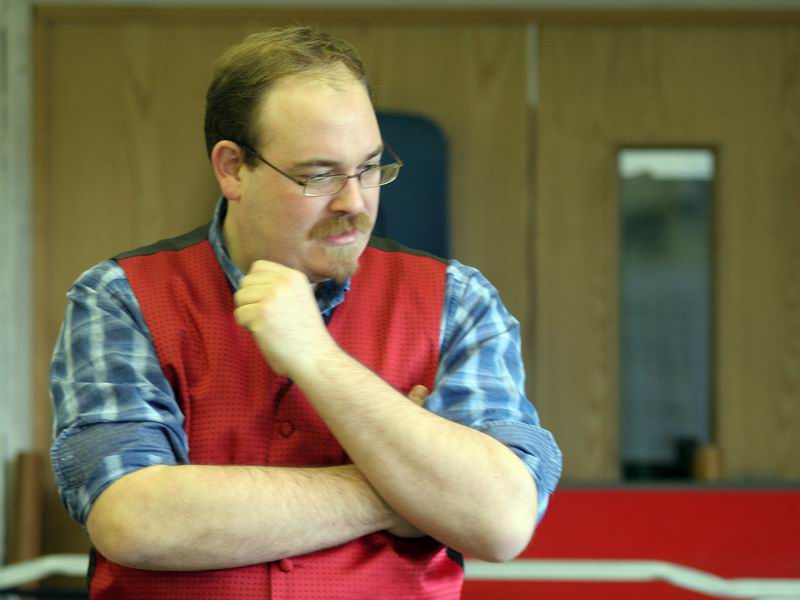From the earliest moves it was clear that David as Boney was intent on pushing fast and hard. The fact that the French had been able to deploy closer meant that I was forced out of my position earlier than anticipated, but that the type of hurried attack being undertaken meant than I was not losing as many men as I would have done if he had undertaken a more painstaking assault.

Lannes' attack on Tauentzien
As Lannes came at Tauentzien the troops under Augereau drove at the predominantly Saxon division of Zeschwitz. Historically they seem to have had a far quieter time of it than they did in the game. Basically the French carved through the woods and rough terrain but as they came out of the Isserstedter Forst they ran up against determined resistance in Isserstedt itself and in the more open territory around it. Some great coups by Zeschwitz’ forces effectively reduced Augereau’s ability to make any progress. Things here ground to a halt for a while until the arrival of Ney.

The French advance through the Isserstedt Forst
The third French Marshal, Soult, had also run into trouble. His forces were schlepping up the narrow defile around the Zwatzenhof towards Rollgen and Lehnsten. He was opposed by the very slender forces of Glt Holtzendorf who had been compelled to use two of his cavalry units to intercept some of Lannes troops as they came through the Zwatzen Hof the other side of Closewitz, lapping round Tauentzien’s left flank. But, seizing his chance, Holtzendorf launched the Schimmelpfennig Hussars down the road at the head of Soult’s column. Constricted by the defile Soult was unable to use his superior numbers and the Prussian hussars carved up the front units of his Corps and threw the rest into confusion. For the next few moves the Prussians acted as the ‘cork in the battle’and threw Soult’s advance out of gear. This was to have a profound effect on the French timetable.

Holtzendorff delays Soult
As Tauentzien’s force withdrew behind the Division of Glt Grawert, the latter’s cavalry broke up Lannes’ pursuit allowing Tauentzien’s troops to reform behind Vierzehnheiligen and then march to their new position between Hermstedt and Klein Romstedt. While this was happening Grawert’s force fought off a series of attacks by Lannes increasingly battered divisions.
The arrival of Ney’s force to support Augereau provided some initial relief as the new French forces proved sufficient to eject Zeschwitz from Isserstedt. But they were not enough to break through Zeschwitz’ division, in fact they could not break out of Isserstedt itself. Again the battle here slowed down, and Zeschwitz looked able to successfully contain the French in this sector.

Ney takes Isserstedt
At this stage the Schimmelpfennig’s charge began to have an operational, rather than simply a local, effect. Lannes’ force was spent and unable to break through Grawert. The force that should have been doing this was the Corps under Soult. Although Soult had finally swept aside Holtzendorff, the latter had done a creditable job in delaying the French and now they had two choices. They could pause and wait until Soult was in a position to attack or throw in the only remaining uncommitted infantry force: the Garde Imperiale. The French were facing a dilemma. If they delayed the Prussians would be in a position to bring into action the Division of Glt Ruchel, which was now making an appearance on the road near Frankendorf. Also delay was not David’s natural instinct, as an aggressive cavalryman he clearly wished to maintain the tempo of the attack so the Garde Imperiale were committed.

Soult finally brushes Holtzendorff aside
Supported by their massive battery it was no surprise to anyone that they carved through the tired Division of Grawert. But in the process two battalions were effectively vapourised as they attacked deployed Prussian artillery and the remaining battalions got through to the other side but were very much worse for wear. As Holtzendorff’s remnants withdrew from Lehnsten to Hermstedt and beyond, Hohenlohe needed to buy a little time to bring Ruchel up and ordered Tauentzien to plug the gap until Ruchel could arrive.

The Guard punch through Grawert's Division
And what of Murat’s cavalry? Well it had made an appearance and had plunged into the gap between Zeschwitz’ position and the right flank of Tauentzien. Ruchel had, though, thrown forward his own cavalry supported by Tauentzien’s own sabres to stave them off for as long as possible.
The Garde Imperiale and Tauentzien’s division were on a collision course. But Tauentzien had ensured that his centre-left was composed of the untouched forces of Schomberg’s Brigade and the skirmishers of von Bila, rather than the more mangled troops of GM Zweiffel. The disordered and debilitated Guard came up in two columns. One, composed of two battalions of Garde Chasseur, faced the Prince Maximilian Musketeers. An attempted charge was repulsed with a fine volley and they failed to make contact. The three unscreened Garde Grenadier battalions that made up the second column also suffered at the hands of the Rosen Fusiliers and one promptly routed.
Game end
The game ended here. Soult was still a good two moves away from being able to launch attacks and Murat’s cavalry was still being held up by the cavalry of Ruchel and Tauentzien. Ruchel’s infantry was close enough to allow the Prussians to fall back to a line Wotschau-Klein Romstedt and then along the road if they needed to. Meanwhile Tauentzien was convinced that another round would probably have seen another one, if not two, Old Guard battalions routing. Although the French had one totally fresh corps it would have been unable, on its own, to bring victory. Certainly the hurried attacks undertaken by the French would have made it hard to co-ordinate this with cavalry attacks by Murat.

Last turn
Personal Performance
I won Man of the Match for this battle. I must say I enjoyed the challenge hugely. The high level of operational fluidity, the exposed position, the need to make judgements and decisions were all great fun. It was also an operational level I was comfortable with, indeed I think 4 brigades (three up, one back) is about the limit I expect a player should be able to handle without permanent subordinates. It was also a nice mixed command and I really enjoyed playing it.
K

1 comment:
I know this is rather an old threat. But thinking of the time the battle was happening in 1806, maybe it is not as "old" from this perspective.
Thank you for your analysis. My Grandgrandfather Carl died in this battle, while being a "Wachtmeister" in the Gettkandt Hussar Regiment. As far as I have understood this, he was placed as "light division" at Grawert and probably fighting the "Isserstedter Forst". Well, I guess, I will never know exactly. But thank you for making history so visual.
Oliver Mark
Post a Comment